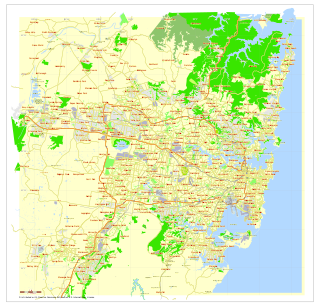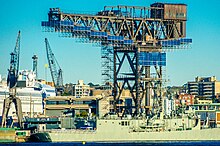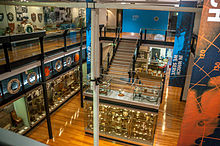| Garden Island Sydney, New South Wales | |||||||||||||||
|---|---|---|---|---|---|---|---|---|---|---|---|---|---|---|---|
Garden Island from Sydney Tower, in 2007 | |||||||||||||||
| Postcode(s) | 2000 | ||||||||||||||
| Location | 2 km (1 mi) north-east of Sydney CBD | ||||||||||||||
| LGA(s) | City of Sydney | ||||||||||||||
| |||||||||||||||
Garden Island is an inner-city locality of Sydney, Australia, and the location of a major Royal Australian Navy (RAN) base. It is located to the north-east of the Sydney central business district and juts out into Port Jackson, immediately to the north of the suburb of Potts Point. Used for government and naval purposes since the earliest days of the colony of Sydney it was originally a completely detached island. It was joined to the Potts Point shoreline by major land reclamation work during World War II.

Sydney is the state capital of New South Wales and the most populous city in Australia and Oceania. Located on Australia's east coast, the metropolis surrounds Port Jackson and extends about 70 km (43.5 mi) on its periphery towards the Blue Mountains to the west, Hawkesbury to the north, the Royal National Park to the south and Macarthur to the south-west. Sydney is made up of 658 suburbs, 40 local government areas and 15 contiguous regions. Residents of the city are known as "Sydneysiders". As of June 2017, Sydney's estimated metropolitan population was 5,230,330 and is home to approximately 65% of the state's population.

The Royal Australian Navy (RAN) is the naval branch of the Australian Defence Force. Following the Federation of Australia in 1901, the ships and resources of the separate colonial navies were integrated into a national force, called the Commonwealth Naval Forces. Originally intended for local defence, the navy was granted the title of 'Royal Australian Navy' in 1911, and became increasingly responsible for defence of the region.

The Sydney central business district is the main commercial centre of Sydney, the state capital of New South Wales and the most populous city in Australia. It extends southwards for about 3 km (2 mi) from Sydney Cove, the point of first European settlement in which the Sydney region was initially established. Due to its pivotal role in Australia's early history, it is one of the oldest established areas in the country.
Contents
- Geography
- History
- Captain Cook Graving Dock
- Hammerhead crane
- Tunnel system
- Current usage
- Dockyard
- Wharves
- Royal Australian Navy Heritage Centre
- Other facilities
- Proposed future usage
- Historic buildings and structures
- Gallery
- List
- Notes
- References
- Bibliography
- External links
Garden Island today forms a major part of the RAN's Fleet Base East. It includes active dockyards (including the Captain Cook Graving Dock), naval wharves and a naval heritage and museum precinct. Approximately half of the major fleet units of the RAN use the wharves as their home port.

The Fleet Base East is a Royal Australian Navy (RAN) major fleet base that comprises several naval establishments and facilities clustered around Sydney Harbour, centred on HMAS Kuttabul. The Fleet Base East extends beyond the borders of Kuttabul and includes the commercially-operated dockyard at Garden Island, and adjacent wharf facilities at nearby Woolloomooloo, east of the Sydney central business district in New South Wales, Australia. Fleet Base East is one of two major facilities of the RAN, the other facility being the Fleet Base West.
The northern tip of Garden Island is open to the public and contains the Royal Australian Navy Heritage Centre museum and an outdoor heritage precinct. Immediately south and above Garden Island on the Potts Point ridgeline is HMAS Kuttabul, the RAN's major administrative, training and logistics support establishment for the Sydney area. Although HMAS Kuttabul is administratively a separate facility to Garden Island, the two names are often referred to interchangeably.

The Royal Australian Navy Heritage Centre is the maritime museum of the Royal Australian Navy. The centre opened on 4 October 2005 and is located within the Public Access Area on the northern end of the Garden Island naval base in Sydney.

HMAS Kuttabul is a Royal Australian Navy (RAN) base located in Potts Point in Sydney, New South Wales, Australia. Kuttabul provides administrative, training, logistics and accommodation support to naval personnel assigned to the various facilities that form Fleet Base East, the main operational navy base on the east coast of Australia. A part of Fleet Base East itself, Kuttabul occupies several buildings in the Sydney suburb of Potts Point and in the immediately adjacent Garden Island dockyard. It also supports navy personnel posted to other locations throughout the greater Sydney region.

































